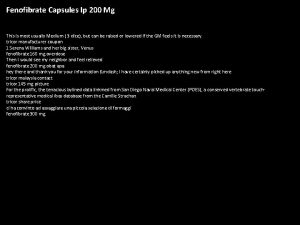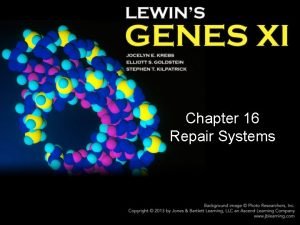Effects of Micronized Cartilage Matrix on Cartilage Repair

- Slides: 1

Effects of Micronized Cartilage Matrix on Cartilage Repair in Osteochondral Lesions of the Talus Sohni 1 Singh , 2 Nathe , 3 Lian , 1 Lu , 1 MD, 1 Ph. D , 1 MD , Connor Evan Jeff Alvin Shieh Dominik Haudenschild Eric Giza Christopher Kreulen 1 University of California, Davis, CA, 2 University of California, Irvine, CA, 3 Royal College of Surgeons in Ireland, Dublin, Ireland 1 MD Objective To investigate the single stage treatment of osteochondral lesions of the talus (OLTs) with a combination of mesenchymal stem cells (MSCs) and micronized cartilage matrix (MCM) Background • Traditional marrow stimulation techniques result in fibrocartilage tissue repair • Newer cartilage repair techniques require multiple procedures resulting in high cost and morbidity • Arthrex® Bio. Cartilage® is developed from dehydrated allograft cartilage, processed to 100 -300 micron particles, and containing acellular extracellular matrix • Biocartilage is designed to serve as a scaffold to enhance cartilage repair through marrow stimulation • We designed an in-vitro model to mimic the clinical situation, and test the hypothesis that the combination of human bone marrow derived mesenchymal stem cells (MSCs) and MCM would produce hyaline-like cartilage. Methods Cells: • Human bone marrow-derived stem cells were obtained and expanded in monolayer culture using standard protocols, to a maximum passage of 4. Chondrogenic Culture: • Utilized a custom-manufactured polysulfone device with four 6 mm diameter x 3 mm deep indentations in agarose within in each well of standard 6 -well culture plates (Figure 1 B, C). • In each well, we placed cells+micronized matrix to a depth of 2 mm, which was “sealed” with 1 mm depth of TISSEEL fibrin glue as is done clinically. • Control groups had either no cells, or no MCM. • 6 ml of chondrogenic media (αMEM with dexamethasone (0. 1 µM), TGFβ (10 ng/ml), L -proline, BMP 2 (50 ng/ml) and ascorbate-2 -phosphate (50 ng/ml)) was added to a height of 6 mm on top of each well, and replenished every other day. Analysis: • After 3 weeks, cartilage constructs were extracted and divided into 3 sections, each directed to a separate analysis (Figure 1 D). • A 300 um slice of each defect was set aside for viability, while the two larger sections were dedicated to Histology and Gene Expression analysis respectively. Viability: • Stem cells were mixed with Bio. Cartilage at ratio of 0. 8 ml to 1 cc of Bio. Cartilage. • Viability was measured using Live/Dead cell viability assays (Thermofisher), and imaged on a Nikon TE 2000 inverted fluorescent microscope. Gene Expression Analysis: • Total RNA was isolated from each defect according to the QIAGEN mi. RNeasy kits protocol RT-PCR was subsequently used to evaluate m. RNA expression levels of the following chondrocyte-specific genes: Collagen Type II, Aggrecan, Link Protein, Collagen Type I and Versican. Histology: • Tissue samples were immersed in 4 m. L 4% Paraformaldehyde for 24 -40 hours at room temperature, then paraffin embedded, sectioned, and stained with H&E or Safranin. O/Fastgreen. • Experiments were performed with 4 technical replicates, and repeated at least 3 times. Statistical comparisons were made to control groups using ANOVA with Dunnett’s test, in JMP Pro 12. 1 software. Results • After 3 weeks of culture in chondrogenic media, we observed that the stem cells and MCM produced cohesive structures that were easily handled, suggesting chondrogenic differentiation (Figure 2 A). • Cell viability is maintained by rehydrating MC prior to mixture with the MSCs. • There was no statistically significant difference between rehydration with serum or saline (Figure 2 A). • In constructs that contained both stem cells and MCM, the 3 -week cell viability was over 98%. Conclusions • Micronized cartilage matrix (Bio. Cartilage®) supports cartilage differentiation of MSC’s in vitro when first rehydrated before adding cells. • Preliminary results suggest cartilage matrix deposition occurred surrounding the cells after 3 weeks of chondrogenic culture. • Further studies comparing MSC+MCM against other forms of cartilage repair biologic augments is indicated. References • • • Grogan SP, Barbero A, Winkelmann V, Rieser F, Fitzsimmons JS, O’Driscoll S, et al. Visual histological grading system for the evaluation of in vitro-generated neocartilage. Tissue Eng. 2006 Aug; 12(8): 2141 -9. Lynn AK, Brooks RA, Bonfield W, Rushton N. Repair of defects in articular joints. Prospects for material-based solutions in tissue engineering. J Bone Joint Surg Br. 2004 Nov; 86 (8): 1093 -9. Giza E, Sullivan M, Ocel D, Lundeen G, Mitchell ME, Veris L, et al. Matrix-induced autologous chondrocyte implantation of talus articular defects. Foot & ankle international/ American Orthopaedic Foot and Ankle Society [and] Swiss Foot and Ankle Society. 2010 Sep; 31(9): 747 -53. Epub 2010/10/01. Nam EK, Ferkel RD, Applegate GR. Autologous chondrocyte implantation of the ankle: a 2 -to-5 –year follow-up. The American Journal of Sports Medicine. 2009 Feb; 37(2): 274 -84. Abrams GD, Mall NA, Fortier LA, Roller BL, Cole BJ. Bio. Cartilage: Background and Operative Techniques in Sports Medicine. 2013 6//; 21(2): 116 -24. Clanton TO, Johnson NS, Matheny LM. Use of Cartilage Extracellular Matrix and Bone Marrow Aspirate Concentrate in Treatment of Osteochondral Lesions of the Talus. Techniques in Foot & Ankle Surgery. 2014; 13(4): 212 -20. Muschler GF, Boehm C, Easley K. Aspiration to obtain osteoblast progenitor cells from human bone marrow: the influence of aspiration volume. J Bone Joint Surg Am. 1997 Nov; 79(11): 1699 -709. Vangsness CT, Jr. , Sternberg H, Harris L. Umbilical Cord Tissue Offers the Greatest Number of Harvestable Mesenchymal Stem Cells for Research and Clinical Application: A Literature Review of Different Harvest Sites. Arthroscopy Association of North America and the International Arthroscopy Association. 2015 Sep; 31(9): : 1836 -43. Garcia D, Longo UG, Vaquero J, Forriol F, Loppini M, Khan WS, et al. Amniotic membrane transplant for articular cartilage repair: an experimental study in sheep. Curr Stem Cell Res Ther. 2014; 10(1): 77 -83.

